Farm Diversification and Sustainability of Multifunctional Peri-Urban Agriculture: Entrepreneurial Attributes of Advanced Diversification in Japan
Abstract
1. Introduction
2. Materials and Methods
2.1. Conceptual Framework
2.1.1. Farm Diversification
2.1.2. Sustainability of Family Farms
2.2. Analytical Framework
2.2.1. Overview
2.2.2. Diversification
2.2.3. Advanced Diversification Measures
2.2.4. Clustering Analysis
2.2.5. Sustainability
2.2.6. Regression Analysis
2.3. Data
3. Results
3.1. Description of the Sample Farms
3.2. Measures for Advanced Diversification
3.3. Clustering Analysis
3.4. Regression Results
4. Discussion
5. Conclusions
Author Contributions
Funding
Acknowledgments
Conflicts of Interest
References
- Marsden, T.; Sonnino, R. Rural Development and the Regional State: Denying Multifunctional Agriculture in the UK. J. Rural Stud. 2008, 24, 422–431. [Google Scholar] [CrossRef]
- Surls, R.; Feenstra, G.; Golden, S.; Galt, R.; Hardesty, S.; Napawan, C.; Wilen, C. Gearing up to Support Urban Farming in California: Preliminary Results of a Needs Assessment. Renew. Agric. Food Syst. 2015, 30, 33–42. [Google Scholar] [CrossRef]
- Lovell, S.T. Multifunctional Urban Agriculture for Sustainable Land Use Planning in the United States. Sustainability 2010, 2, 2499–2522. [Google Scholar] [CrossRef]
- Yokohari, M.; Amati, M.; Bolthouse, J.; Kurita, H. Restoring Urban Fringe Landscapes through Urban Agriculture: The Japanese Experience. disP Plan. Rev. 2010, 46, 51–59. [Google Scholar] [CrossRef]
- Kurita, H.; Yokohari, M.; Bolthouse, J. The Potential of Intra-Regional Supply and Demand of Agricultural Products in an Urban Fringe Area: A Case Study of the Kanto Plain, Japan. Geogr. Tidsskr. J. Geogr. 2009, 109, 147–159. [Google Scholar]
- Yokohari, M.; Takeuchi, K.; Watanabe, T.; Yokota, S. Beyond Greenbelts and Zoning: A New Planning Concept for the Environment of Asian Mega-Cities. In Urban Ecology; Springer: Boston, MA, USA, 2008; pp. 783–796. [Google Scholar]
- Hoornweg, D.; Munro-Faure, P. Urban Agriculture for Sustainable Poverty Alleviation and Food Security; FAO Africa: Accra, Ghana, 2008. [Google Scholar]
- Pölling, B.; Mergenthaler, M.; Lorleberg, W. Professional Urban Agriculture and Its Characteristic Business Models in Metropolis Ruhr, Germany. Land Use Policy 2016, 58, 366–379. [Google Scholar] [CrossRef]
- Zasada, I. Multifunctional Peri-Urban Agriculture—A Review of Societal Demands and the Provision of Goods and Services by Farming. Land Use Policy 2011, 28, 639–648. [Google Scholar] [CrossRef]
- Ilbery, B.W. Farm Diversification as an Adjustment Strategy on the Urban Fringe of the West Midlands. J. Rural Stud. 1991, 7, 207–218. [Google Scholar]
- Pölling, B.; Mergenthaler, M. The Location Matters: Determinants for “Deepening” and “Broadening” Diversification Strategies in Ruhr Metropolis’ Urban Farming. Sustainability 2017, 9, 1168. [Google Scholar] [CrossRef]
- Sinclair, R. Von Thünen and Urban Sprawl. Ann. Assoc. Am. Geogr. 1967, 57, 72–87. [Google Scholar] [CrossRef]
- Boncinelli, F.; Bartolini, F.; Casini, L. Structural Factors of Labour Allocation for Farm Diversification Activities. Land Use Policy 2018, 71, 204–212. [Google Scholar] [CrossRef]
- Lange, A.; Piorr, A.; Siebert, R.; Zasada, I. Spatial Differentiation of Farm Diversification: How Rural Attractiveness and Vicinity to Cities Determine Farm Households’ Response to the CAP. Land Use Policy 2013, 31, 136–144. [Google Scholar] [CrossRef]
- Meraner, M.; Heijman, W.; Kuhlman, T.; Finger, R. Determinants of Farm Diversification in the Netherlands. Land Use Policy 2015, 42, 767–780. [Google Scholar] [CrossRef]
- Clark, J. Entrepreneurship and Diversification on English Farms: Identifying Business Enterprise Characteristics and Change Processes. Entrep. Reg. Dev. 2009, 21, 213–236. [Google Scholar] [CrossRef]
- Mc Fadden, T.; Gorman, M. Exploring the Concept of Farm Household Innovation Capacity in Relation to Farm Diversification in Policy Context. J. Rural Stud. 2016, 46, 60–70. [Google Scholar] [CrossRef]
- Bryant, C.R.; Johnston, T.R.R. Agriculture in the City’s Countryside; University of Toronto Press: Toronto, ON, Canada, 1992. [Google Scholar]
- Fuller, A.M. From Part-Time Farming to Pluriactivity: A Decade of Change in Rural Europe. J. Rural Stud. 1990, 6, 361–373. [Google Scholar] [CrossRef]
- Van der Ploeg, J.D.; Roep, D. Multifunctionality and Rural Development: The Actual Situation in Europe. Multifunctional Agriculture: A New Paradigm for European Agriculture and Rural Development; Ashgate Publishing Company: Aldershot, UK, 2003; pp. 37–54. [Google Scholar]
- Shane, S.; Venkataraman, S. The Promise of Entrepreneurship as a Field of Research. Acad. Manag. Rev. 2000, 25, 217–226. [Google Scholar] [CrossRef]
- Hansson, H.; Ferguson, R.; Olofsson, C. Psychological Constructs Underlying Farmers’ Decisions to Diversify or Specialise Their Businesses—An Application of Theory of Planned Behaviour. J. Agric. Econ. 2012, 63, 465–482. [Google Scholar] [CrossRef]
- Lumpkin, G.T.; Dess, G.G. Clarifying the Entrepreneurial Orientation Construct and Linking It to Performance. Acad. Manag. Rev. 1996, 21, 135–172. [Google Scholar] [CrossRef]
- McElwee, G. Farmers as Entrepreneurs: Developing Competitive Skills. J. Dev. Entrep. 2006, 11, 187–206. [Google Scholar] [CrossRef]
- McElwee, G. A Taxonomy of Entrepreneurial Farmers. Int. J. Entrep. Small Bus. 2008, 6, 465–478. [Google Scholar] [CrossRef]
- Yoshida, S.; Yagi, H.; Garrod, G. Determinants of Farm Diversification: Entrepreneurship, Marketing Capability and Family Management. J. Small Bus. Entrep. 2019. [Google Scholar] [CrossRef]
- Hansson, H.; Ferguson, R.; Olofsson, C.; Rantamäki-Lahtinen, L. Farmers’ Motives for Diversifying Their Farm Business—The Influence of Family. J. Rural Stud. 2013, 32, 240–250. [Google Scholar] [CrossRef]
- Yoshida, S.; Yagi, H.; Kiminami, A. Determinants of Farm Diversification in Peri-Urban Agriculture: A Spatial Econometric Analysis with Municipality-Level Data in Kanto Region. Stud. Reg. Sci. 2019, 49. in press. [Google Scholar]
- Barnes, A.P.; Hansson, H.; Manevska-Tasevska, G.; Shrestha, S.S.; Thomson, S.G. The Influence of Diversification on Long-Term Viability of the Agricultural Sector. Land Use Policy 2015, 49, 404–412. [Google Scholar] [CrossRef]
- Fotiadis, A.; Yeh, S.-S.; Huan, T.-C. Applying Configural Analysis to Explaining Rural-Tourism Success Recipes. J. Bus. Res. 2016, 69, 1479–1483. [Google Scholar] [CrossRef]
- Veeck, G.; Che, D.; Veeck, A. America’s Changing Farmscape: A Study of Agricultural Tourism in Michigan. Prof. Geogr. 2006, 58, 235–248. [Google Scholar] [CrossRef]
- Schilling, B.J.; Attavanich, W.; Jin, Y. Does Agritourism Enhance Farm Profitability? J. Agric. Resour. Econ. 2014, 39, 69–87. [Google Scholar]
- Hung, W.-T.; Ding, H.-Y.; Lin, S.-T. Determinants of Performance for Agritourism Farms: An Alternative Approach. Curr. Issues Tour. 2016, 19, 1281–1287. [Google Scholar] [CrossRef]
- Barbieri, C. A Comparison of Agritourism and Other Farm Entrepreneurs: Implications for Future Tourism and Sociological Research on Agritourism. In Proceedings of the 2008 Northeastern Recreation Research Symposium, Bolton Landing, NY, USA, 30 March–1 April 2008. [Google Scholar]
- Ohe, Y. Educational Tourism in Agriculture and Identity of Farm Successors. Tour. Econ. 2018, 24, 167–184. [Google Scholar] [CrossRef]
- McElwee, G.; Bosworth, G. Exploring the Strategic Skills of Farmers across a Typology of Farm Diversification Approaches. J. Farm Manag. 2010, 13, 819–838. [Google Scholar]
- Morgan, S.L.; Marsden, T.; Miele, M.; Morley, A. Agricultural Multifunctionality and Farmers’ Entrepreneurial Skills: A Study of Tuscan and Welsh Farmers. J. Rural Stud. 2010, 26, 116–129. [Google Scholar] [CrossRef]
- Porter, M.E. Competitive Advantage: Creating and Sustaining Superior Performance. New York Free 1985, 43, 214. [Google Scholar]
- Miles, R.E.; Snow, C.C. Organizational Strategy, Structure, and Process; McGraw-Hill: New York, NY, USA, 1978. [Google Scholar]
- Barney, J.B.; Hoskisson, R.E. Strategic Groups: Untested Assertions and Research Proposals. Manag. Decis. Econ. 1990, 11, 187–198. [Google Scholar] [CrossRef]
- DeSarbo, W.S.; Anthony Di Benedetto, C.; Song, M.; Sinha, I. Revisiting the Miles and Snow Strategic Framework: Uncovering Interrelationships between Strategic Types, Capabilities, Environmental Uncertainty, and Firm Performance. Strateg. Manag. J. 2005, 26, 47–74. [Google Scholar] [CrossRef]
- Ebbes, P.; Grewal, R.; DeSarbo, W.S. Modeling Strategic Group Dynamics: A Hidden Markov Approach. Quant. Mark. Econ. 2010, 8, 241–274. [Google Scholar] [CrossRef]
- Fiss, P.C. Building Better Causal Theories: A Fuzzy Set Approach to Typologies in Organization Research. Acad. Manag. J. 2011, 54, 393–420. [Google Scholar] [CrossRef]
- Leask, G.; Parker, D. Strategic Groups, Competitive Groups and Performance within the UK Pharmaceutical Industry: Improving Our Understanding of the Competitive Process. Strateg. Manag. J. 2007, 28, 723–745. [Google Scholar] [CrossRef]
- Lebacq, T.; Baret, P.V.; Stilmant, D. Sustainability Indicators for Livestock Farming. A Review. Agron. Sustain. Dev. 2013, 33, 311–327. [Google Scholar] [CrossRef]
- Van Calker, K.J.; Berentsen, P.B.M.; Giesen, G.W.J.; Huirne, R.B.M. Identifying and Ranking Attributes That Determine Sustainability in Dutch Dairy Farming. Agric. Hum. Values 2005, 22, 53–63. [Google Scholar] [CrossRef]
- Ollenburg, C.; Buckley, R. Stated Economic and Social Motivations of Farm Tourism Operators. J. Travel Res. 2007, 45, 444–452. [Google Scholar] [CrossRef]
- Barbieri, C. Assessing the Sustainability of Agritourism in the US: A Comparison between Agritourism and Other Farm Entrepreneurial Ventures. J. Sustain. Tour. 2013, 21, 252–270. [Google Scholar] [CrossRef]
- Pearce, P.L. Farm Tourism in New Zealand: A Social Situation Analysis. Ann. Tour. Res. 1990, 17, 337–352. [Google Scholar] [CrossRef]
- Amanor-Boadu, V. Diversification Decisions in Agriculture: The Case of Agritourism in Kansas. Int. Food Agribus. Manag. Rev. 2013, 16, 57. [Google Scholar]
- Flanigan, S.; Blackstock, K.; Hunter, C. Generating Public and Private Benefits through Understanding What Drives Different Types of Agritourism. J. Rural Stud. 2015, 41, 129–141. [Google Scholar] [CrossRef]
- Cassia, F.; Bruni, A.; Magno, F. Heritage Preservation: Is It a Motivation for Agritourism Entrepreneurship? Herit. Manag. E Impresa Quali Sinergie 2015. [Google Scholar] [CrossRef]
- Rois-Díaz, M.; Lovric, N.; Lovric, M.; Ferreiro-Domínguez, N.; Mosquera-Losada, M.R.; Den Herder, M.; Graves, A.; Palma, J.H.N.; Paulo, J.A.; Pisanelli, A.; et al. Farmers’ Reasoning behind the Uptake of Agroforestry Practices: Evidence from Multiple Case-Studies across Europe. Agrofor. Syst. 2018, 92, 811–828. [Google Scholar] [CrossRef]
- Nickerson, N.P.; Black, R.J.; McCool, S.F. Agritourism: Motivations behind Farm/Ranch Business Diversification. J. Travel Res. 2001, 40, 19–26. [Google Scholar] [CrossRef]
- Barbieri, C.; Mahoney, E. Why Is Diversification an Attractive Farm Adjustment Strategy? Insights from Texas Farmers and Ranchers. J. Rural Stud. 2009, 25, 58–66. [Google Scholar] [CrossRef]
- Tew, C.; Barbieri, C. The Perceived Benefits of Agritourism: The Provider’s Perspective. Tour. Manag. 2012, 33, 215–224. [Google Scholar] [CrossRef]
- Barbieri, C.; Valdivia, C. Recreation and Agroforestry: Examining New Dimensions of Multifunctionality in Family Farms. J. Rural Stud. 2010, 26, 465–473. [Google Scholar] [CrossRef]
- McGehee, N.G.; Kim, K.; Jennings, G.R. Gender and Motivation for Agri-Tourism Entrepreneurship. Tour. Manag. 2007, 28, 280–289. [Google Scholar] [CrossRef]
- Sharpley, R.; Vass, A. Tourism, Farming and Diversification: An Attitudinal Study. Tour. Manag. 2006, 27, 1040–1052. [Google Scholar] [CrossRef]
- Vik, J.; McElwee, G. Diversification and the Entrepreneurial Motivations of Farmers in Norway. J. Small Bus. Manag. 2011, 49, 390–410. [Google Scholar] [CrossRef]
- Läpple, D.; Kelley, H. Spatial Dependence in the Adoption of Organic Drystock Farming in Ireland. Eur. Rev. Agric. Econ. 2015, 42, 315–337. [Google Scholar] [CrossRef]
- Barney, J.B. Gaining and Sustaining Competitive Advantage, 2nd ed.; Prentice Hall: Upper Saddle River, NJ, USA, 2002. [Google Scholar]
- Kellermanns, F.W.; Eddleston, K.A. Corporate Entrepreneurship in Family Firms: A Family Perspective. Entrep. Theory Pract. 2006, 30, 809–830. [Google Scholar] [CrossRef]
- Short, J.C.; Payne, G.T.; Brigham, K.H.; Lumpkin, G.T.; Broberg, J.C. Family Firms and Entrepreneurial Orientation in Publicly Traded Firms: A Comparative Analysis of the S&P 500. Fam. Bus. Rev. 2009, 22, 9–24. [Google Scholar]
- Habbershon, T.G.; Williams, M.; MacMillan, I.C. A Unified Systems Perspective of Family Firm Performance. J. Bus. Ventur. 2003, 18, 451–465. [Google Scholar] [CrossRef]
- Habbershon, T.G.; Nordqvist, M.; Zellweger, T. Transgenerational Entrepreneurship: Exploring Growth and Performance in Family Firms across Generations; Edward Elgar Publishing: Cheltenham, UK, 2010; pp. 1–38. [Google Scholar]
- Lohrberg, F.; Lička, L.; Scazzosi, L.; Timpe, A. Urban Agriculture Europe; Jovis: Kenmore, NY, USA, 2016. [Google Scholar]
- Guitart, D.; Pickering, C.; Byrne, J. Past Results and Future Directions in Urban Community Gardens Research. Urban For. Urban Green. 2012, 11, 364–373. [Google Scholar] [CrossRef]
- Litt, J.; Soobader, M.-J.; Turbin, M.S.; Hale, J.W.; Buchenau, M.; Marshall, J.A. The Influence of Social Involvement, Neighborhood Aesthetics, and Community Garden Participation on Fruit and Vegetable Consumption. Am. J. Public Health 2011, 101, 1466–1473. [Google Scholar] [CrossRef] [PubMed]
- Litt, J.S.; Schmiege, S.J.; Hale, J.W.; Buchenau, M.; Sancar, F. Exploring Ecological, Emotional and Social Levers of Self-Rated Health for Urban Gardeners and Non-Gardeners: A Path Analysis. Soc. Sci. Med. 2015, 144, 1–8. [Google Scholar] [CrossRef]
- Soga, M.; Cox, D.T.C.; Yamaura, Y.; Gaston, K.J.; Kurisu, K.; Hanaki, K. Health Benefits of Urban Allotment Gardening: Improved Physical and Psychological Well-Being and Social Integration. Int. J. Environ. Res. Public Health 2017, 14, 71. [Google Scholar] [CrossRef]
- Barton, J.; Pretty, J. What Is the Best Dose of Nature and Green Exercise for Improving Mental Health? A Multi-Study Analysis. Environ. Sci. Technol. 2010, 44, 3947–3955. [Google Scholar] [CrossRef]
- Van den Berg, A.E.; van Winsum-Westra, M.; De Vries, S.; Van Dillen, S.M.E. Allotment Gardening and Health: A Comparative Survey among Allotment Gardeners and Their Neighbors without an Allotment. Environ. Health 2010, 9, 74. [Google Scholar] [CrossRef]
- Pope, R.D.; Prescott, R. Diversification in Relation to Farm Size and Other Socioeconomic Characteristics. Am. J. Agric. Econ. 1980, 62, 554–559. [Google Scholar] [CrossRef]
- Bartolini, F.; Andreoli, M.; Brunori, G. Explaining Determinants of the On-Farm Diversification: Empirical Evidence from Tuscany Region. Bio-Based Appl. Econ. 2014, 3, 137–157. [Google Scholar]
- Sumner, D.A.; Wolf, C.A. Diversification, Vertical Integration, and the Regional Pattern of Dairy Farm Size. Rev. Agric. Econ. 2002, 24, 442–457. [Google Scholar] [CrossRef]
- Mann, S.; Besser, T. Diversification and Work Satisfaction: Testing a Claim by Marx and Engels for Farmers. Rural Sociol. 2017, 82, 349–362. [Google Scholar] [CrossRef]
- Miller, D. The Correlates of Entrepreneurship in Three Types of Firms. Manag. Sci. 1983, 29, 770–791. [Google Scholar] [CrossRef]
- Covin, J.G.; Slevin, D.P. Strategic Management of Small Firms in Hostile and Benign Environments. Strateg. Manag. J. 1989, 10, 75–87. [Google Scholar] [CrossRef]
- Grande, J.; Madsen, E.L.; Borch, O.J. The Relationship between Resources, Entrepreneurial Orientation and Performance in Farm-Based Ventures. Entrep. Reg. Dev. 2011, 23, 89–111. [Google Scholar] [CrossRef]
- Wang, Y.; Feng, H. Customer Relationship Management Capabilities: Measurement, Antecedents and Consequences. Manag. Decis. 2012, 50, 115–129. [Google Scholar] [CrossRef]
- Keramati, A.; Mehrabi, H.; Mojir, N. A Process-Oriented Perspective on Customer Relationship Management and Organizational Performance: An Empirical Investigation. Ind. Mark. Manag. 2010, 39, 1170–1185. [Google Scholar] [CrossRef]
- Nonaka, I.; Ikujiro, N.; Takeuchi, H. The Knowledge-Creating Company: How Japanese Companies Create the Dynamics of Innovation; Everyman’s Library; Oxford University Press: Oxford, UK, 1995. [Google Scholar]
- Alavi, M.; Leidner, D.E. Knowledge Management and Knowledge Management Systems: Conceptual Foundations and Research Issues. MIS Q. 2001, 25, 107–136. [Google Scholar] [CrossRef]
- Morck, R.; Yeung, B. Why Investors Sometimes Value Size and Diversification: The Internalization Theory on Synergy; University of Michigan: Ann Arbor, MI, USA, 1997. [Google Scholar]
- Narasimhan, O.; Rajiv, S.; Dutta, S. Absorptive Capacity in High-Technology Markets: The Competitive Advantage of the Haves. Mark. Sci. 2006, 25, 510–524. [Google Scholar] [CrossRef]
- Song, M.; Di Benedetto, C.A.; Nason, R.W. Capabilities and Financial Performance: The Moderating Effect of Strategic Type. J. Acad. Mark. Sci. 2007, 35, 18–34. [Google Scholar] [CrossRef]
- Vorhies, D.W.; Morgan, N.A. A Configuration Theory Assessment of Marketing Organization Fit with Business Strategy and Its Relationship with Marketing Performance. J. Mark. 2003, 67, 100–115. [Google Scholar] [CrossRef]
- Jack, S.L.; Anderson, A.R. The Effects of Embeddedness on the Entrepreneurial Process. J. Bus. Ventur. 2002, 17, 467–487. [Google Scholar] [CrossRef]
- McKeever, E.; Jack, S.; Anderson, A. Embedded Entrepreneurship in the Creative Re-Construction of Place. J. Bus. Ventur. 2015, 30, 50–65. [Google Scholar] [CrossRef]
- Akgün, A.A.; Nijkamp, P.; Baycan, T.; Brons, M. Embeddedness of Entrepreneurs in Rural Areas: A Comparative Rough Set Data Analysis. Tijdschrift voor economische en sociale geografie 2010, 101, 538–553. [Google Scholar] [CrossRef]
- Blundel, R. Network Evolution and the Growth of Artisanal Firms: A Tale of Two Regional Cheese Makers. Entrep. Reg. Dev. 2002, 14, 1–30. [Google Scholar] [CrossRef]
- Stam, W.; Elfring, T. Entrepreneurial Orientation and New Venture Performance: The Moderating Role of Intra-and Extraindustry Social Capital. Acad. Manag. J. 2008, 51, 97–111. [Google Scholar] [CrossRef]
- Che, D.; Veeck, A.; Veeck, G. Sustaining Production and Strengthening the Agritourism Product: Linkages among Michigan Agritourism Destinations. Agric. Hum. Values 2005, 22, 225–234. [Google Scholar] [CrossRef]
- Scrucca, L.; Fop, M.; Murphy, T.B.; Raftery, A.E. Mclust 5: Clustering, Classification and Density Estimation Using Gaussian Finite Mixture Models. R J. 2016, 8, 289. [Google Scholar] [CrossRef]
- Ilbery, B.; Bowler, I.; Clark, G.; Crockett, A.; Shaw, A. Farm-Based Tourism as an Alternative Farm Enterprise: A Case Study from the Northern Pennines, England. Reg. Stud. 1998, 32, 355. [Google Scholar]
- Meert, H.; Van Huylenbroeck, G.; Vernimmen, T.; Bourgeois, M.; Van Hecke, E. Farm Household Survival Strategies and Diversification on Marginal Farms. J. Rural Stud. 2005, 21, 81–97. [Google Scholar] [CrossRef]
- Yagi, H.; Garrod, G. The Future of Agriculture in the Shrinking Suburbs: The Impact of Real Estate Income and Housing Costs. Land Use Policy 2018, 76, 812–822. [Google Scholar] [CrossRef]
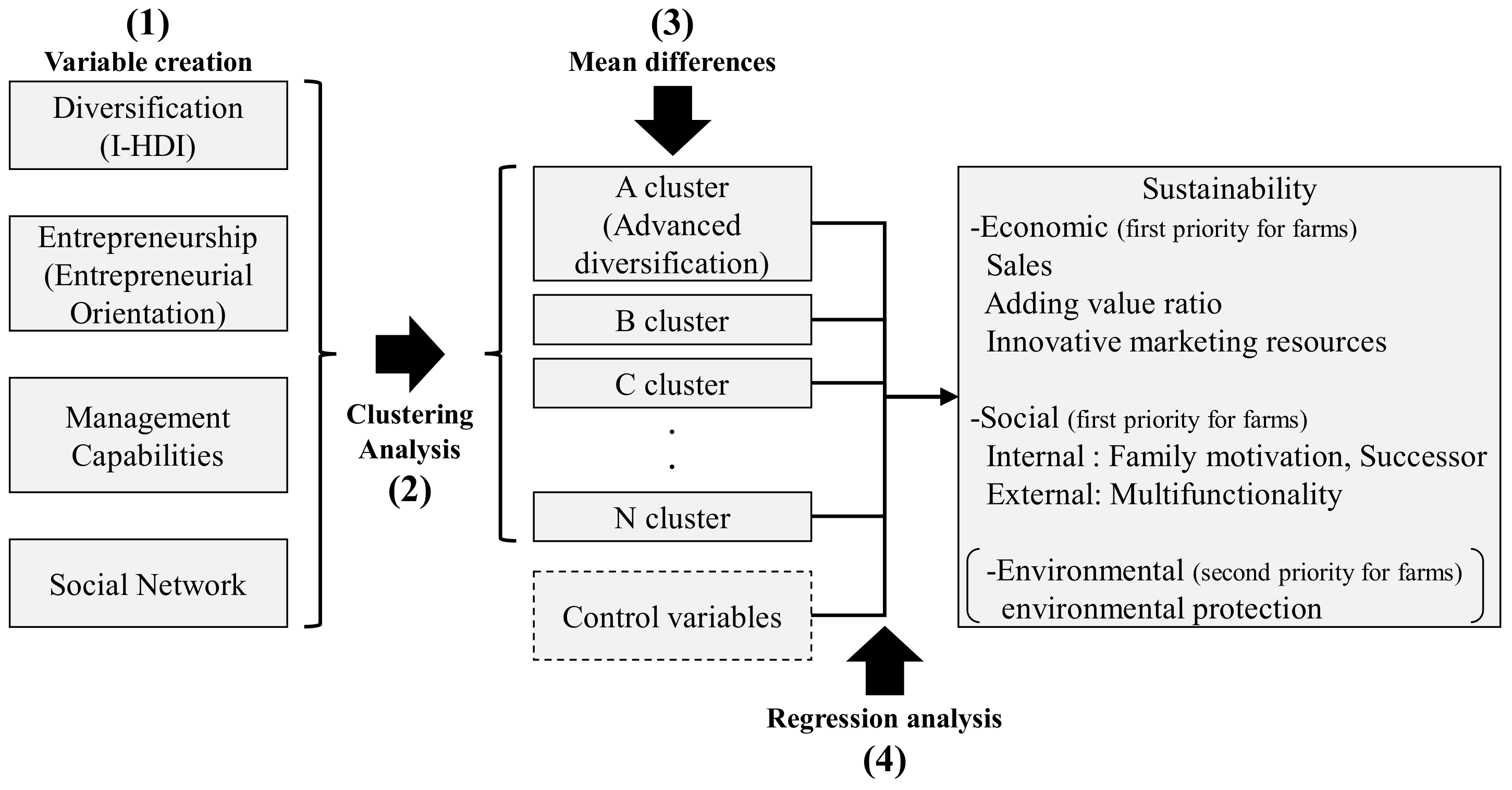
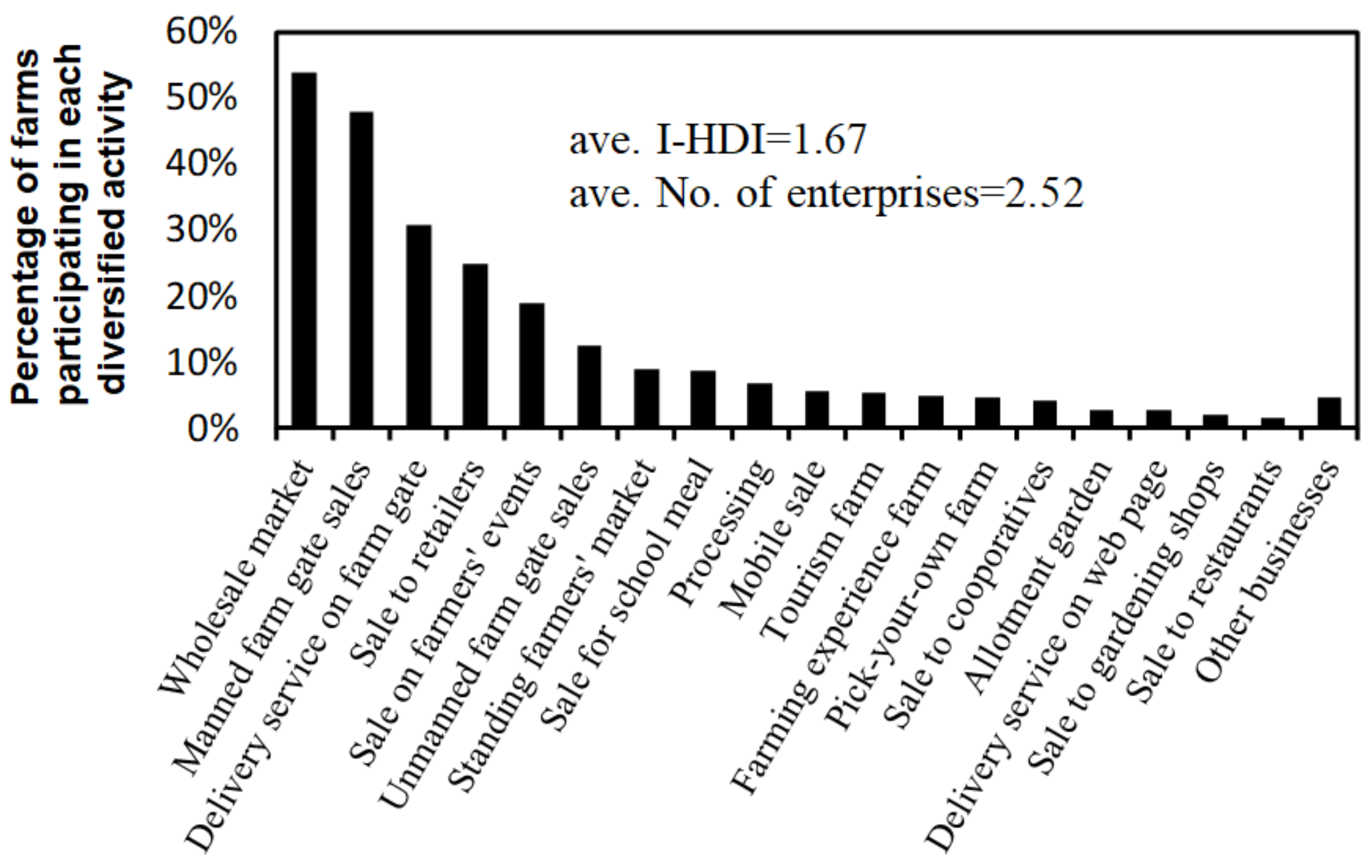
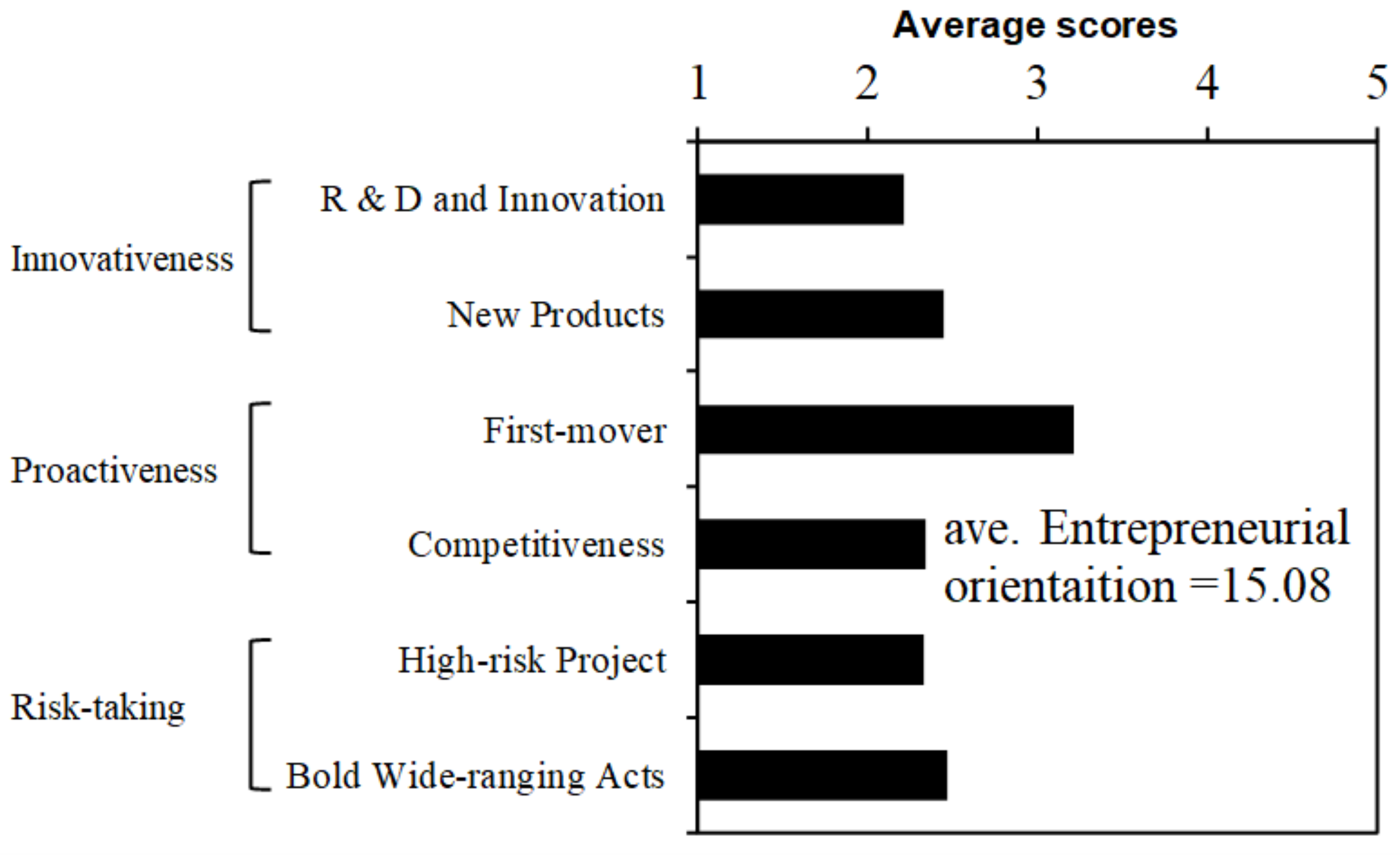
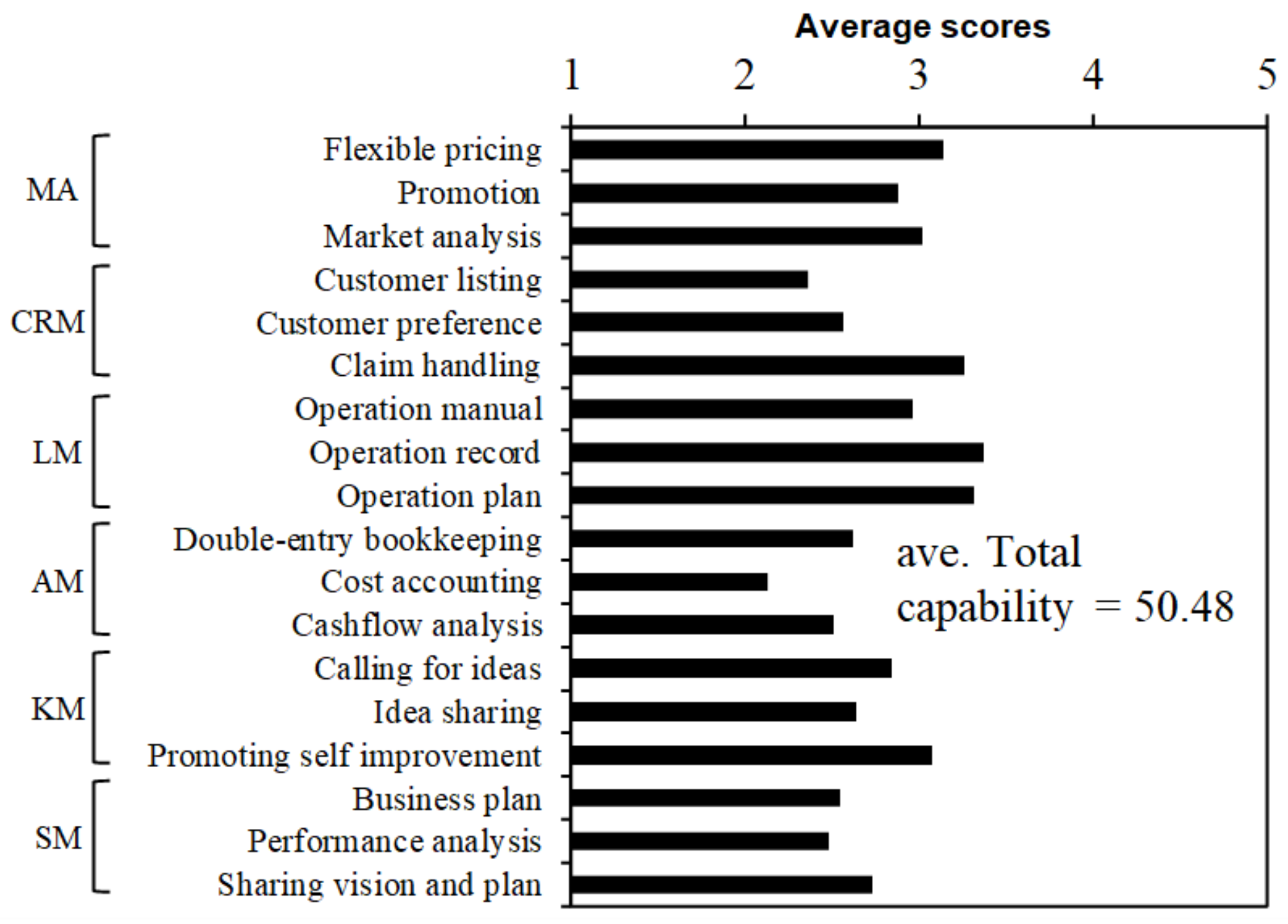
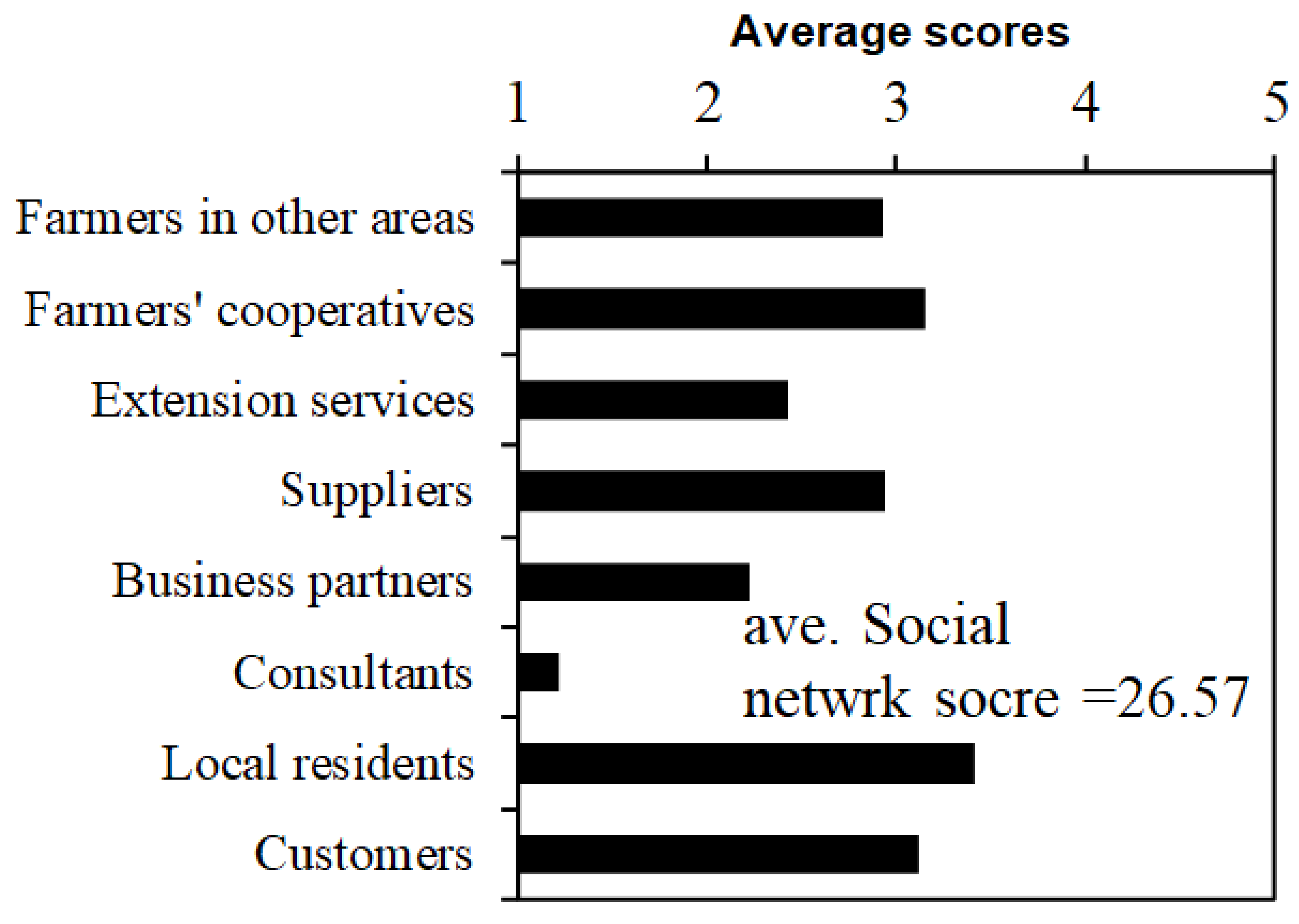

| Articles | Country | Type | Methodology (Sample Size) | Motivation for Farm Diversification | |||
| Economic | Social | Environment | |||||
| Internal | External | ||||||
| [54] | the U.S. | Farm diversification | Factor analysis (292) | additional income, losing government support, market opportunity, other farm successes, resource utilization | family involvement | customer interaction | |
| [55] | the U.S. | Farm diversification | Factor analysis (638) | additional income, enhanced financial conditions, market opportunity, uncertainty and risk reduction | family involvement | customer interaction | |
| [56] | the U.S. | Farm diversification | Factor analysis (243) | additional income, enhanced financial condition, market opportunity, resource utilization, uncertainty and risk reduction | family involvement, farm succession | education | |
| [58] | the U.S. | Farm diversification | Mean difference (383) | additional income, other farm successes, resource utilization | family involvement | education | |
| [50] | the U.S. | Farm diversification | Principal Component Analysis (112) | additional income, economic survival | community survival, customer interaction, preserve culture | ||
| [10] | the U.K. | Farm diversification | Cross-tabulation (120) | additional income, location, resource utilisation | |||
| [59] | the U.K. | Farm diversification | Cross-tabulation (150) | additional income, enhanced financial condition | family involvement | food supply | |
| [51] | the U.K. | Farm diversification | Case study (25) | additional income, getting financial support, labour shortage market opportunity, uncertainty and risk | family involvement, | education, heritage preservation | |
| [27] | Sweden | Farm diversification | Factor analysis (309) | enhanced financial condition, resource utilisation | family involvement | ||
| [60] | Norway | Farm diversification | Regression analysis (1607) | additional income, resource utilisation | family involvement | ||
| [52] | Italy | Farm diversification | Factor analysis (226) | additional income, uncertainty and risk reduction | family involvement | heritage preservation (rural and agrifood) | |
| [49] | New Zealand | Farm diversification | Case study (13) | additional income, location, resource utilisation | consumer interaction | ||
| [57] | the U.S. | Crop diversification (agroforestry) | Factor analysis (729) | economic benefit, tax benefit | environment protection | ||
| [53] | Europe | Crop diversification (agroforestry) | Cross-tabulation (183) | resource utilization, getting subsidies | Tradition, Animal welfare | environment protection, Landscape | |
| [61] | Ireland | Crop diversification (organic) | Spatial analysis (597) | enhanced financial condition | environment protection | ||
| Variables | Mean | Standard Deviation | Min. | Max. | Descriptions (Unit) | |
|---|---|---|---|---|---|---|
| Labour | 383 | 272 | 0 | 2050 | (Man-day) * Total amount of both family and non-family labour excluding main manager and volunteers in a year. | |
| Land area | 114 | 84 | 0 | 480 | (a) Total amount of land farmed including tenanted farmland | |
| Farm type | Vegetable | 0.59 | 0.49 | 0 | 1 | Dummy variable, 1 = ‘Vegetable’ accounts for two-thirds of total farm sales |
| Fruit | 0.31 | 0.46 | 0 | 1 | Dummy variable, 1 = ‘Fruit’ accounts for two-thirds of total farm sales | |
| Real Estate Business Rate | 46.0 | 31.9 | 0 | 100 | (%) the percentage of income from real estate business in the total of farm income | |
| Farmer’s age | 62.8 | 11.6 | 25 | 80 | (years old) Class mark of eight scales ranging from 1 (10–20) to 12 (80-) | |
| Social network | 26.4 | 6.1 | 8 | 40 | Sum of eight dummy variables below | |
| Break down ** | Farmers in other areas | 2.92 | 1.33 | 1 | 5 | 5-Likert scale ranging from 1 (None) to 5 (Once a week) |
| Farmers’ cooperative | 3.16 | 1.11 | 1 | 5 | 5-Likert scale ranging from 1 (None) to 5 (Once a week) | |
| Extension services | 2.43 | 1.10 | 1 | 5 | 5-Likert scale ranging from 1 (None) to 5 (Once a week) | |
| Suppliers | 2.94 | 1.13 | 1 | 5 | 5-Likert scale ranging from 1 (None) to 5 (Once a week) | |
| Business partners | 2.22 | 1.40 | 1 | 5 | 5-Likert scale ranging from 1 (None) to 5 (Once a week) | |
| Consultants | 1.22 | 0.63 | 1 | 5 | 5-Likert scale ranging from 1 (None) to 5 (Once a week) | |
| Local residents | 3.41 | 1.50 | 1 | 5 | 5-Likert scale ranging from 1 (None) to 5 (Once a week) | |
| Customers | 3.12 | 1.53 | 1 | 5 | 5-Likert scale ranging from 1 (None) to 5 (Once a week) | |
| Economic performance | Sales | 696 | 612 | 0 | 3000 | (10 thousand yen) Class mark of 12 scales ranging from 1 (None) to 12 (3,000) |
| Adding-value ratio | 29.0 | 33.3 | 0 | 100 | (%) the percentage of production that is given more added value than other farms in the total of product | |
| Innovative marketing resources | 1.12 | 1.60 | 0 | 7 | Sum of the seven dummy variables below | |
| Web page | 0.12 | 0.32 | 0 | 1 | Dummy variable, 1 = ‘Web page’ is introduced for farm business | |
| Leaflet | 0.18 | 0.38 | 0 | 1 | Dummy variable, 1 = ‘Leaflet’ is introduced for farm business | |
| Product tag | 0.16 | 0.37 | 0 | 1 | Dummy variable, 1 = ‘Product tag’ is introduced for farm business | |
| Farm logo | 0.14 | 0.35 | 0 | 1 | Dummy variable, 1 = ‘Farm logo’ is introduced for farm business | |
| Business card | 0.25 | 0.44 | 0 | 1 | Dummy variable, 1 = ‘Business card’ is introduced for farm business | |
| Social Networking Service (SNS) | 0.07 | 0.26 | 0 | 1 | Dummy variable, 1 = ‘SNS’ is introduced for farm business | |
| Direct mail | 0.19 | 0.39 | 0 | 1 | Dummy variable, 1 = ‘Direct mail’ is introduced for farm business | |
| Internal social performance | Successor | 0.30 | 0.46 | 0 | 1 | Dummy variable, 1 = ‘Successor’ is nominated from family |
| Family Motivation *** | 3.02 | 1.05 | 1 | 5 | 5-Likert scale ranging from 1 (strongly disagree) to 5 (strongly agree) | |
| External social performance **** | Multifunctionality | 14.9 | 5.1 | 5 | 25 | Sum of five dummy variables below |
| Farm visits | 2.53 | 1.49 | 1 | 5 | 5-Likert scale ranging from 1 (strongly disagree) to 5 (strongly agree) | |
| Landscape management | 3.03 | 1.21 | 1 | 5 | 5-Likert scale ranging from 1 (strongly disagree) to 5 (strongly agree) | |
| Interacting with the public | 2.62 | 1.29 | 1 | 5 | 5-Likert scale ranging from 1 (strongly disagree) to 5 (strongly agree) | |
| Agricultural understanding | 2.97 | 1.26 | 1 | 5 | 5-Likert scale ranging from 1 (strongly disagree) to 5 (strongly agree) | |
| Local food supply | 3.73 | 1.27 | 1 | 5 | 5-Likert scale ranging from 1 (strongly disagree) to 5 (strongly agree) | |
| Cluster | A | B | C | F Test | |
|---|---|---|---|---|---|
| Name of Cluster | Advanced Diversification | Conventional Diversification | Conventional Specialisation | ||
| No. of Samples | 42 (12.8%) | 185 (50.0%) | 159 (37.2%) | ||
| Inverse HDI (I-HDI) | (1~) | 2.49 | 1.92 | 1.06 | A > B > C |
| Total capability (TC) | (15~75) | 62.58 | 50.33 | 46.51 | A > B > C |
| Entrepreneurial orientation (EO) | (6~30) | 19.56 | 14.09 | 14.70 | A > B, A > C |
| Social network (SN) | (8~40) | 27.22 | 21.49 | 19.35 | A > B > C |
| Cluster | A | B | C | F Test | ||
|---|---|---|---|---|---|---|
| Name of Cluster | Advanced Diversification | Conventional Diversification | Conventional Specialisation | |||
| Labour | (Man-day) | 514 | 390 | 341 | A > B, A > C | |
| Farm size | (a) | 142 | 111 | 110 | ||
| Farm type | Vegetable | (1 = Yes, 0 = No) | 0.62 | 0.46 | 0.74 | C > B |
| Fruit | (1 = Yes, 0 = No) | 0.19 | 0.44 | 0.19 | B > A, B > C | |
| Real estate business rate | (0~1) | 0.44 | 0.49 | 0.43 | ||
| Farmer’s age | (years old) | 58.2 | 63.0 | 63.7 | C > A | |
| Performance | Sales | (104 yen) | 992 | 692 | 622 | A > B, A > C |
| Adding value ratio | (%) | 53.3 | 28.2 | 24.5 | A > B, A > C | |
| Innovative marketing resources | (0~7) | 2.67 | 1.28 | 0.52 | A > B > C | |
| Successor | (1 = Yes, 0 = No) | 0.36 | 0.32 | 0.25 | ||
| Family motivation | (1~5) | 3.44 | 2.97 | 2.97 | A > B, A > C | |
| Multifunctionality | (5~25) | 19.7 | 14.9 | 13.5 | A > B > C | |
| Economic Performance | Internal Social Performance | External Social Performance | |||||||||||
|---|---|---|---|---|---|---|---|---|---|---|---|---|---|
| Sales | Added-Value Ratio | Innovative Marketing Resources | Family Motivation | Successor | Multi-Functionality | ||||||||
| Intercept | 882.62 ** | 998.43 ** | 32.53 ** | 38.24 ** | 0.66 * (1.94) | 1.26 ** (3.54) | 3.32 ** | 3.32 ** | −8.18 ** (0.00) | −7.65 ** (0.00) | 14.42 ** | 15.45 ** | |
| type | Advanced diversification | 249.49 ** | 133.68 | 28.16 ** | 22.45 ** | 1.47 ** (4.34) | 0.86 ** (2.37) | 0.41 * | 0.40 * | 0.76 + (2.13) | 0.23 (1.26) | 5.08 ** | 4.05 ** |
| Conventional diversification | 115.81 * | 5.71 | 0.60 ** (1.83) | 0.00 | 0.53 + (1.69) | 1.02 + | |||||||
| Conventional Specialisation | −115.81 * | −5.71 | −0.60 ** (0.55) | 0.00 | −0.53 + (0.59) | −1.02 + | |||||||
| Farm size | 3.28 ** | 0.02 | 0.002 ** (1.002) | 0.001 * | 0.01 ** (1.01) | 0.01 ** | |||||||
| Farm type | Vegetable | −208.12 * | −4.13 | −0.83 ** (0.44) | −0.29 | 0.09 (1.09) | −1.58 + | ||||||
| Fruit | −296.55 ** | −7.66 | 0.23 (1.25) | −0.10 | 0.09 (1.10) | −0.63 | |||||||
| City | Yokohama | −174.42 * | −3.30 | −0.39 * (0.68) | −0.31 + | −0.29 (0.75) | 1.87 * | ||||||
| Ichikawa | −151.71 | −6.80 | −0.11 (0.90) | −0.50 * | −0.53 (0.55) | −0.40 | |||||||
| Real Estate Business Rate | −268.26 ** | 4.86 | −0.06 (0.94) | −0.23 | 0.53 (1.70) | 0.59 | |||||||
| Farmer’s age | −2.52 | −0.09 | −0.01 ** (0.99) | 0.00 | 0.09 ** (1.09) | −0.04 + | |||||||
| F test (p value) | 0.00 | 0.00 | 0.00 | 0.00 | |||||||||
| Adjusted R-squared (Nagelkerke) | 0.31 | 0.06 | (0.61) | 0.05 | (0.28) | 0.19 | |||||||
© 2019 by the authors. Licensee MDPI, Basel, Switzerland. This article is an open access article distributed under the terms and conditions of the Creative Commons Attribution (CC BY) license (http://creativecommons.org/licenses/by/4.0/).
Share and Cite
Yoshida, S.; Yagi, H.; Kiminami, A.; Garrod, G. Farm Diversification and Sustainability of Multifunctional Peri-Urban Agriculture: Entrepreneurial Attributes of Advanced Diversification in Japan. Sustainability 2019, 11, 2887. https://doi.org/10.3390/su11102887
Yoshida S, Yagi H, Kiminami A, Garrod G. Farm Diversification and Sustainability of Multifunctional Peri-Urban Agriculture: Entrepreneurial Attributes of Advanced Diversification in Japan. Sustainability. 2019; 11(10):2887. https://doi.org/10.3390/su11102887
Chicago/Turabian StyleYoshida, Shingo, Hironori Yagi, Akira Kiminami, and Guy Garrod. 2019. "Farm Diversification and Sustainability of Multifunctional Peri-Urban Agriculture: Entrepreneurial Attributes of Advanced Diversification in Japan" Sustainability 11, no. 10: 2887. https://doi.org/10.3390/su11102887
APA StyleYoshida, S., Yagi, H., Kiminami, A., & Garrod, G. (2019). Farm Diversification and Sustainability of Multifunctional Peri-Urban Agriculture: Entrepreneurial Attributes of Advanced Diversification in Japan. Sustainability, 11(10), 2887. https://doi.org/10.3390/su11102887





